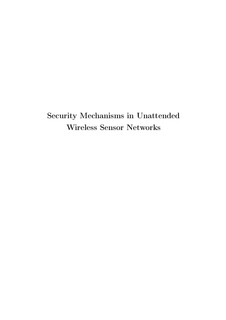| dc.description.abstract | Wireless Sensor Networks (WSNs) consisting of a large number of sensor nodes
are being deployed in potentially hostile environments for applications such as
forest fire detection, battlefield surveillance, habitat monitoring, traffic management,
etc. One common assumption in traditional WSNs is that a trusted
third party, i.e., a sink, is assumed to be always available to collect sensed
data in a real time or near real time fashion. Although many WSNs operate
in such an on-site mode, there are WSN applications that do not fit into the
real time data collection mode. For example, data collection in Unattended
WSNs (UWSNs) relies on the periodical appearance of a mobile sink. As most
existing security solutions developed for traditional WSNs rely on the presence
of a trusted third party, it makes them not applicable to UWSNs directly. This
motivates the research on security mechanisms for UWSNs.
This dissertation contributes to security mechanisms in UWSNs from three
important aspects, as, confidentiality and reliability, trust management, and
capture resistance. The first aspect addresses data confidentiality and data
reliability in UWSNs. We propose a data distribution scheme to provide forward
secrecy, probabilistic backward secrecy and data reliability. Moreover,
we demonstrate that backward secrecy of the historical data can be achieved
through homomorphic encryption and key evolution. Furthermore, we propose
a constrained optimization algorithm to further improve the above two data
distribution schemes.
The second study introduces trust management in UWSNs. We propose a
set of efficient and robust trust management schemes for the case of UWSNs.
The Advanced Scheme utilizes distributed trust data storage to provide trust
data reliability and takes the advantages of both Geographic Hash Table
(GHT) and Greedy Perimeter Stateless Routing (GPSR) to find storage nodes
and to route trust data to them. In this way, it significantly reduces storage
cost caused by distributed trust data storage and provides resilience to node
compromise and node invalidation.
The third study investigates how to detect a captured node and to resist
node capture attack in UWSNs. We propose a node capture resistance and
key refreshing scheme for UWSNs based on the Chinese remainder theorem.
The scheme is able to provide forward secrecy, backward secrecy and collusion
resistance for diminishing the effects of capture attacks. | no_NO |
